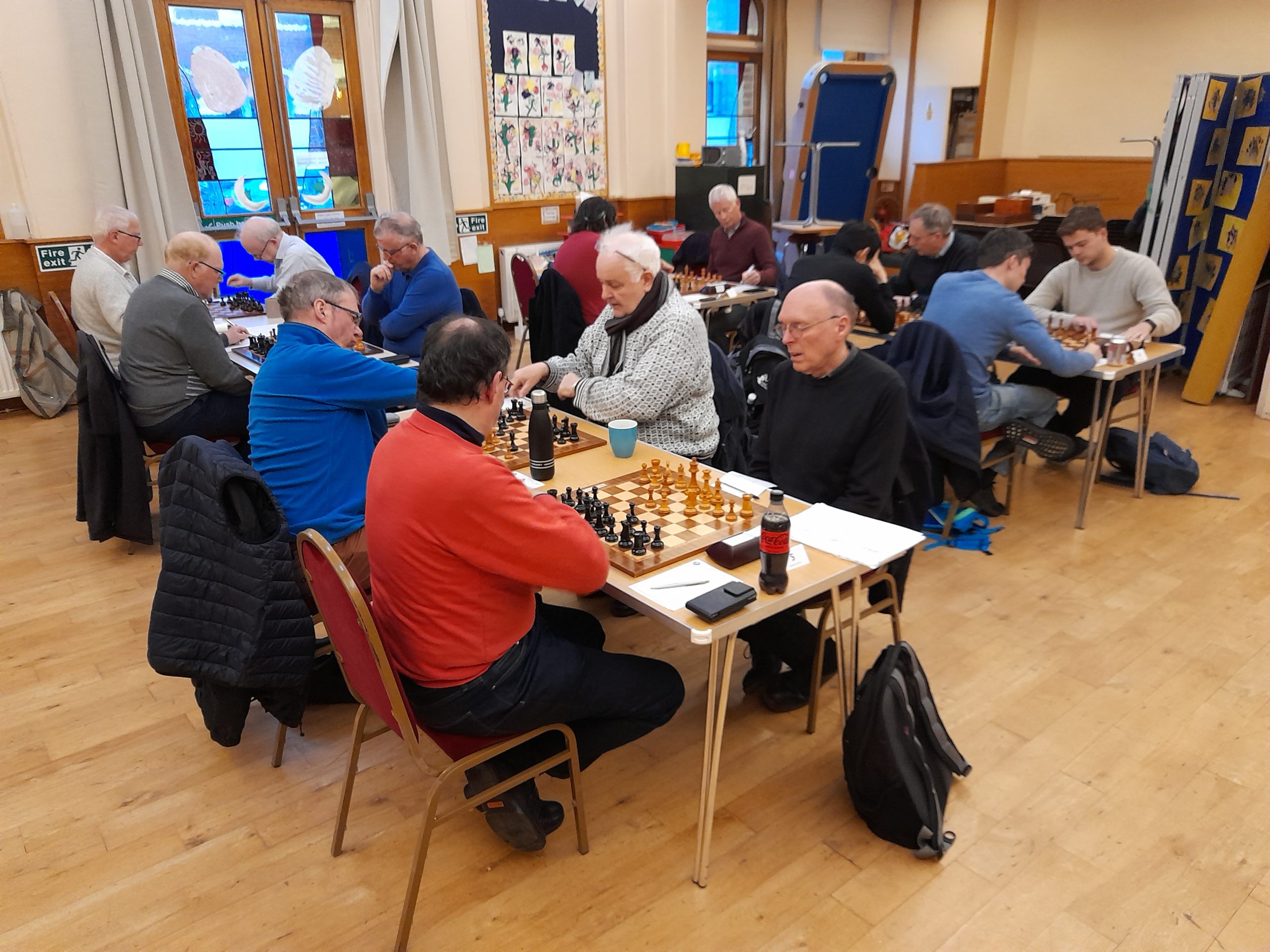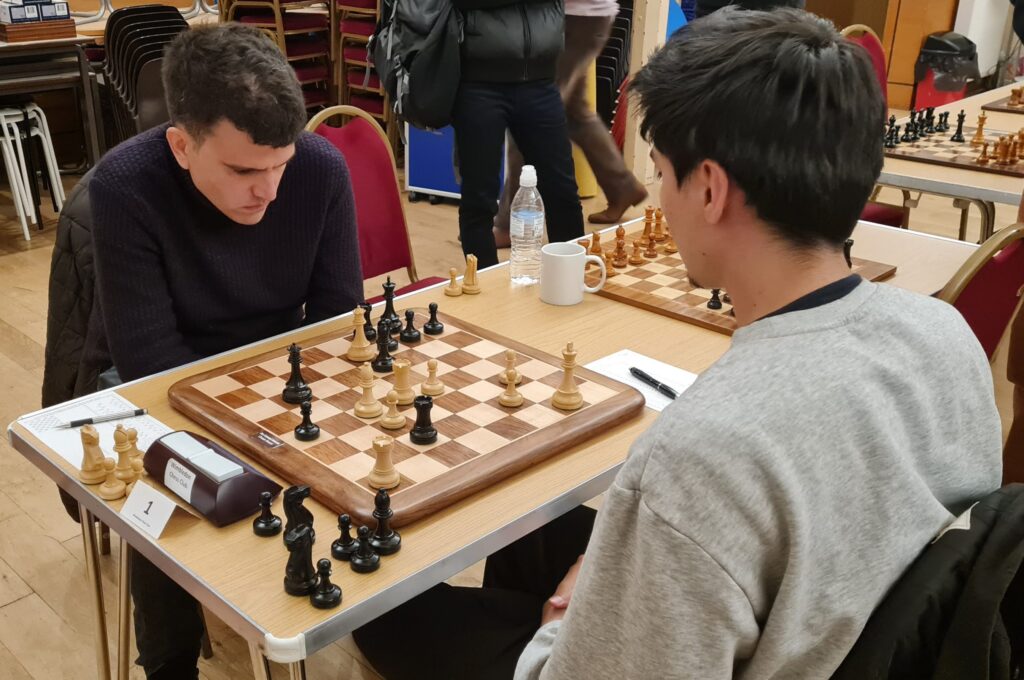Surrey League division 1 match played at St Winefride’s Church Hall, Wimbledon on 20 April 2023
Although Kingston’s first team has had an historically successful season, it has been far from a cakewalk. We have faced some very strong teams and, also, some teams which, though not so strong on paper, have given us some anxious moments.
One example was our very first Surrey Trophy match of the season, back in October, in which we only just beat a significantly outrated Wimbledon 1 by 4.5-3.5. In the return match, for the final Surrey encounter of the season, we faced Wimbledon again, at their venue, and found that they had pulled out all the stops to assemble a very strong team, which included a 2400+ IM on board 1 and Russell Granat, on a trip up from the south coast, on board 2. Could we complete a clean sweep of all eight Surrey matches against this line-up?
The first results were not very propitious, as both Alan Scrimgour and I had short draws with the white pieces. Alan’s King’s Gambit was met by Ian Heppell’s Falkbeer Counter-Gambit (1. e4 e5. 2. f4 d5), though after 3. exd5 Ian continued 3…exf4 rather than the thematic 3…e4. He obtained some pressure on the kingside, but was unable to make it count and a draw was soon agreed. Dan Rosen played the Modern Defence against me, but after some manoeuvring a threefold repetition occurred, as we both decided that we didn’t like the position enough to continue. Don Luis Rentero, founder of the great Linares tournament in Spain who loved players to fight and hated draws so much he imposed penalties on non-triers, might have fined us.

On board 3 Russell Picot played the French Defence against Vladimir Li. A series of exchanges led to a rook ending in which Vladimir had a slight advantage in pawn structure. He refused Picot’s first draw offer, but after a few more moves decided that he didn’t have enough to justify playing on, so the result was another Kingston draw with White.
Things did not improve when the board 2 game ended suddenly. The opening had been Russell Granat’s favourite Ruy Lopez Worrall Attack – White plays 6. Qe2 instead of Re1. Mike Healey, defending a difficult position with Granat attacking on the kingside, overlooked a move which simultaneously threatened mate and a loose bishop. 2.5-1.5 to Wimbledon, who had three Whites on the remaining four boards.
On board 6 John Foley had played his usual Caro-Kann and his opponent, Neil Cannon, had chosen the Two Knights Variation. Cannon went straight for the kingside jugular, but Foley calmly blunted the attack and, with a strong knight on e5 against his opponent’s less effective bishop, turned down a draw on move 26. Black was able to launch a pawn attack on the queenside which it was hard for White to counter. In fact, Stockfish gives Black a 2.6 advantage in this position:
Neil was clearly at a loss as to how to defend it, as he now gave up the exchange: 32. Rxe5. Playing an ending, John was in his element, and on reaching this position he engineered a zugzwang:
Meanwhile, the game between Jasper Tambini and Will Taylor had started as a Petrov, the opening moves being: 1. e4 e5 2. Nf3 Nf6 3. Nxe5 d6 4. Nf3 Nxe4 5. d4 d5 6. Bd3 Bd6 7. O-O O-O 8. c4 c6 9. Qc2. Will commented “This is a sharp line, and Jasper remembered it a little less well than I did (he went slightly astray on move 12, and also fell behind on the clock, after which it became increasingly tricky for him.” The key position after move 11 was this:
Jasper played 12. Nc3 here, but, according to Will, White has to play 12. b4 to stop the a3 knight reaching c5. There followed 12…Bxe5 13. dxe5 Nac5 14. cxd5 cxd5 15. b4 Nxd3 16. Qxd3 Nxc3 17. Qxf5 d4 18. Bb2 Qd5 and Black had an advantage as he was dominating the centre of the board. White took off Black’s knight, but this gave Black a dangerous passed pawn on c3. A few moves later this position was reached, with White trying to counter Black’s queening threat by attacking the black king:
This was the denouement: 24. Re7 Rf8 25. e6 c1=Q 26. exf7+ Kh8 (Rxf7 was possible, but Will was sensibly being very careful) 27. Re8 and now Will simplified: 27…Qxe1+ 28. Rxe1 Qxf7 29. White resigns. This made it 3.5-2.5 to Kingston. We needed one point from the remaining two games.
Those games, on boards 1 and 8, were extremely complex, and in the case of board 8 the position was so wild that for some time it was hard to call. It was a battle of the English Opening specialists, so inevitably one of them, Peter Andrews, was playing against his favourite opening. Tony Hughes castled queenside and an exciting game developed with the players attacking on opposite flanks. White already had a bishop en prise here:
But he now decided to complicate things further by playing 19. Nxb5. Peter comments: “A blunder according to Stockfish, turning +2 into –3, but terrifying at the board. I was worried about 19…Qxb5 20. Qe6+ Nf7 21. Bxc4 with a threat of Qf6 and mate on g7.” Play continued 19…fxe3 20. Bxc4+ Nf7 21. Rhe1 Qc6, and Peter adds that he now felt confident for the first time in the game as the queen performs many functions on c6. White continued to play without any concern for material, and this position was reached after 24. Qe5:
Peter says: “Threatening Qg7 mate, and the knight on f7 is pinned. For half a second I wondered if I should resign, and then realised that it was my opponent, not I, who had hallucinated.” What had White missed? (see footnote below *). Peter wrapped the game up smoothly, and Kingston had an unassailable 4.5-2.5 lead.
The heavyweight clash on top board was the last to finish, enthralling those players who gathered round as David Maycock and IM Alberto Suarez Real reached the climactic phase playing on increments. It had started as a Sveshnikov Sicilian. I’m not qualified to comment on the theory of the opening, but it’s clear that piece activity is the major theme, as on move 16 both players passed up chances to capture pawns, presumably because it would have given open lines to the other side. A few moves later this was the position, with Black to play:
Now if 25…Qxa6 26. Rd8 wins, so instead Alberto played Qb6, defending d8 and attacking f2. David blocked this by 26. Rd4, and after 26…Rc2 27. Bc4. White was now attacking Black’s f7 weak point. After 27…Be6 David retreated 28. Bf1 and there followed 28…Rxc3. Here David had to decide which rook to take the a5 pawn with. He chose to capture with the “a” rook, which allowed 29…Rc1, creating problems for White on the first rank, which, in extreme time trouble, were finally too much to defend against. It was a pity that after such a close encounter, with David trading blows in complex positions with an IM, the pressure of playing on increments told.

In the end Kingston’s trio of winning Black players (Will, John and Peter) had ensured that we finished with a perfect eight wins out of eight in the Surrey Trophy. A tremendous team effort across a long season had culminated in victory in one of our toughest matches, by the same score as in our first match against Wimbledon (4.5-3.5).
* The saving grace was 24…Qxc4+! 25. bxc4 Nxe5 26. Rxe5. White only has two pawns for the two pieces, and Black was able to manoeuvre his knight round to f7 to counter White’s doubling of rooks on the seventh rank.
David Rowson, first-team captain

